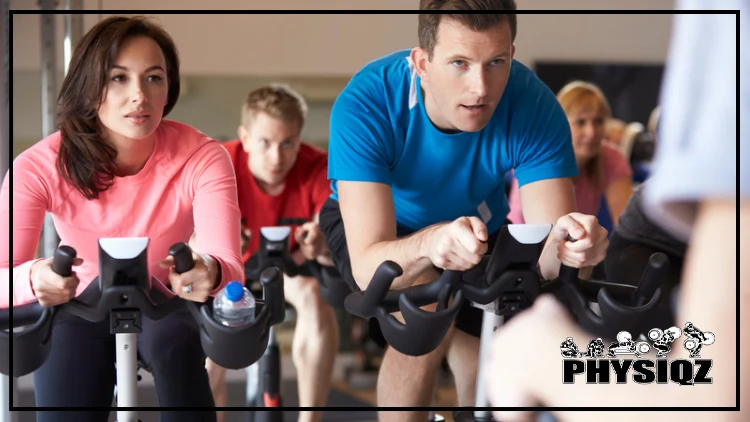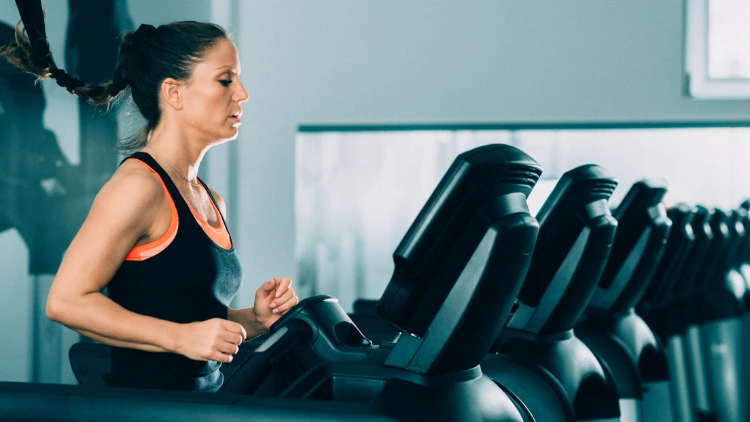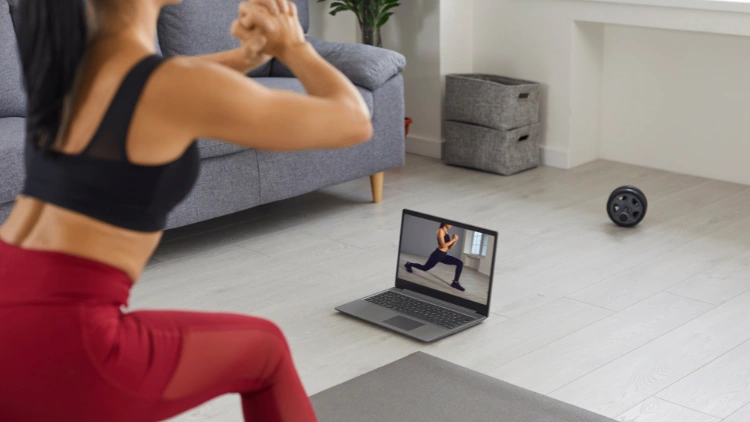
When using Peloton, calories burned is always a huge point of curiosity since Peloton cycling classes are commonly used to lose weight and calories in vs calories out is the fundamental of weight loss.1
However, Peloton offers a large selection of classes so we’ll review peloton calories burned the calories burned in each Pelton cycling class, as well as each one of their 37 classes.
We’ll also cover why calories burned isn’t always the most important factor when choosing a class, how to burn more calories no matter the class, and the accuracy of Peloton’s calorie tracking device so you can find out if their tracker, or your smart watch is a better gauge on calories burned.
Peloton Calories Burned: What Class Burns the Most Calories in 1 Hour or 60 Minutes?
Cycling for 60 minutes is quite a long duration, so the calories burned on a Peloton will be relatively high. However, it depends on the class to determine which one burns the most calories in an hour. Due to the intensity of some sessions, not all classes are available in this 60 minute timeframe, but that doesn’t mean these 1 hour classes are lacking heat.
While bootcamp classes will be expanded on later in this article, the best Peloton class for weight loss that wins the award for most calories burned in 60 minutes is the Full Body Bootcamp classes.
Regardless of the teacher, one can expect to burn between 700 and 1000 calories due to the constant variation of exercise along with the amount of energy exerted, these sessions are sure to leave participants sweating.
As for the Peloton class that burns the least amount of calories in an hour, Restorative Yoga burns roughly 100 calories and the meditation classes don’t burn any additional calories.
Peloton Calories Burned Per Class
One hour classes may sound appealing due to the calorie burn potential, but there are several sessions ranging from just 10 minutes all the way up to 90 minutes and each burn a particular amount of calories.

Source: Maridav via Canva.com2
The below list of calories burned in Peloton classes can help users choose which classes they can fit into their schedule as well as indicating whether they need to adjust their diet or other workouts in conjunction with estimated calorie burn.
Amount of Calories Burned During Peloton Cycling Classes
Peloton cycling classes can burn anywhere from a few 100 calories up to 1400 calories in the matter of 30-90 minutes so it’s important to check the amount of calories burned for a specific class.
1. Warm Up Ride: A warm up class may not seem worth mentioning, but this 10 minute cycling class can burn 95 calories and either be in addition to a Peloton workout plan or just allow riders to get in a super quick workout between daily tasks.
2. Cool Down Ride: Similar to the warm up class, the cool down session is meant to be done in conjunction with another workout and gives the body a chance to regulate after a tougher ride. However, the 100 calories burned in just 10 minutes is nothing for someone to turn their nose up at.
3. Cycling Beginner Class: Beginner rides range from 15 to 20 minutes and the rider should expect to burn between 150 and 250 calories. These sessions truly are for those getting comfortable with the Peloton and will help ease them into a good routine.
4. Beginner-Advance Rides: As beginners get their footing, they can move to the beginner advance class which ups time and intensity. These sessions range between 30 and 45 minutes and burn between 250 to 450 calories.
5. Low Impact Rides: For those recovering from hard workouts, injuries, or for anyone needing to take it easy, a low impact ride can be as short as 10 minutes up to 45 minutes. The most calories anyone can expect to burn in this class is around 400.
6. Power Zone Rides: Power zone classes require a Functional Threshold Power Test (FTP Test) to be taken before participating for riders to discover their power zones. Power zones are individualized and broken down in 7 zones from easiest to hardest.
Power zone rides will allow each participant to workout to their customized levels by exercising in power zone levels dictated by instructors
Rides last between 30 and 90 minutes and riders can burn anywhere between 350 to 1400 calories and can transition anyone into becoming a cycling body transformation male or female.
7. Climb Rides: Regardless of the amount of time available to workout, a climb ride can get the heart pumping. Riders can choose classes that last just 10 minutes up to 60 minutes, which can burn between 110 and 800 calories. A climb ride consists of high resistance which emulates cycling uphill, which not only is great for the heart, but also helps strengthen the legs and glutes.
8. Live DJ Rides: Looking for a fun 20 to 45 minute ride that doesn’t necessarily have a laid out path, the live DJ rides offer music from an inhouse Peloton DJ and tons of upbeat interaction with the coaches. Not to mention, calories burned on Peloton for cycling with a live DJ is between 190 to 415 calories per session.
9. Intervals Rides: When it comes to calories burned on Peloton, the Peloton HIIT (High Intensity Interval Training), Tabata, and other interval cycling classes are second to none when needing to expend bursts of energy.3 Just as the name suggests, these sessions consist of intervals of heavy and hard cycling with short active rest periods.
Because these classes can be so intense, they start at just 5 minutes for beginners and burn roughly 80 calories and extend all the way to 60 minutes and burn nearly 700 calories.
10. Heart Rate Rides: While Peloton no longer produces Heart Rate Zone classes, they are still available to participate in. Similar to the Power Zone classes, these rides focus on the heart rates of each participant and speed and resistance are adjusted per person. The average calories burned in HRZ classes are about 600 per 60 minute class.
11. Themed Rides: Ranging from 20 minutes to an hour, the theme rides are perfect for those who are wanting an engaging and fun ride that suits their interests. From Disney to Hamilton, anyone can find a session to satisfy them and burn 150 to 300 calories to boot.
12. Music Rides: Like themed rides, music rides consist of artists or genres and last anywhere from 20 minutes to 60 minutes while burning up to 600 calories per hour.
13. Groove Rides: For those wanting to take their mind off cycling, groove rides incorporate choreography that goes along with the beat of the music. 150 to 500 can be burned during these fun and upbeat 20 to 45 minute classes.
14. Pro Cycle Rides: Taught by cyclists who have actually ridden in events such as the Tour de France, Pro Cycle rides are intense and work to build stamina and endurance. Whether riders choose a 30 minute ride which burns around 400 calories or a 60 minute class that burns 770 calories, everyone will feel like a pro.
15. Cycle Bootcamp Rides: Bike Bootcamps are a combo of cycling and strength work. The strength portion can include bodyweight work, light weights, or bands and promote full body workouts. These classes have the potential to burn between 400 and 800 calories in a 30 to 60 minute timeframe and a great class to add when trying to achieve a Peloton strength before and after picture.
16. Scenic Rides: Not only does the scenic cycling class help riders feel immersed in a different world, it will also add burning calories to the list of chores done for the day. A 10 minute ride will burn roughly 100 calories while a 60 minute ride will burn around 600; so saddle up and take a tour of the Las Vegas strip, a national park, or a tropical destination.

Source: microgen via Canva.com4
Number of Calories Burned From Peloton Running & Treadmill Classes
While some Peloton users may only have the stationary bike, their treadmill classes can burn 350-800 calories depending on the class taken.
17. Endurance Runs: For those looking to increase their running times, utilizing the Peloton Tread or an old fashioned run outside, the endurance classes last 30, 45, or 60 minutes. During this time, runners are taken through a program to maximize their skills and will reportedly burn between 350 and 700 calories.
18. Tempo Runs: For those looking to kill some calories while running at a sustained speed, the tempo runs are a great way to get lost in the music and focus on the rhythm of the run. Runners can decide to run for 20, 30, 45, or 60 minutes and can expect to burn 650 calories per hour during the running tempo class on Peloton.
19. Tread Bootcamp: Similar to the cycling bootcamps, the Tread bootcamps not only utilize running, but also strength and core exercise to maximize workout time. These boot camps last anywhere between 30 minutes to an hour and can burn up to 800 calories while achieving both cardio and strength workouts.

Source: studioroman via Canva.com5
Calories Burned Working Out With Peloton Strength Classes
Strength training with Peloton is a great way to work on a full body recomposition because they burn calories as well as build muscle. Remember, the calories burned and body fat percentage is only one factor into getting a dream body.
20. Bodyweight Strength Classes: For those who lack extra equipment, Peloton bodyweight workouts can still help participants build strength without any weights. Whether users choose a 10 minute arms class or a 45 minute full body workout, gaining strength is the primary goal to these classes with an added benefit of burning between 50 to 200 calories.
Users can also take advantage of pre-built multi week programs and work toward Crush Your Core Peloton before and after results.
21. Weighted Strength Classes: For those who own weights, 10 to 30 minutes may only burn up to 150 calories, but is a great way to supplement a cardio workout while building muscle tone.
22. Resistance Band Strength Classes: Resistance bands are an alternative to weight and bodyweight training and just as beneficial. Whether working on upper body, lower body, or core, participants can choose to feel the burn anywhere from 5 to 20 minutes while burning up to 100 calories.
23. Barre Classes: Barre classes have become increasingly popular through the years; using a ballet bar, those working out focus on low impact exercises that target holds and pulses that work different muscle groups throughout the body. Peloton barre classes are from 10 to 45 minutes with an expected calorie burn of 50 to 350.
24. Pilates Classes: Those looking to increase core strength can join one of many Pilates classes that last between 10 and 45 minutes. While Pilates only burns up to 200 calories for the 45 minute class; supplementing a shorter class with cardio or adding it on a rest day can increase calories burned for the week.
25. Prenatal Classes: Preparing for birth and staying fit through pregnancy is important for many women, so incorporating a prenatal strength class is a low impact way to burn 100 calories, at most, while strength training from 5 to 20 minutes.

Source: isitsharp via Canva.com6
Calories Burned From Participating in Peloton Yoga Classes
While yoga isn’t typically used to burn calories, it surely burns more calories than simply sitting or standing alone. Plus, yoga has countless benefits such as mobility, relieving stress, and a feeling of well-being.
26. Yoga Basics: For anyone wanting to get into Yoga, the Peloton Yoga Basics class walks users through beginner poses while focusing on technique. As far as Peloton calories burned during yoga, no substantial calories will be burned during these short 5 minute classes; but will help members progress to other classes.
27. Yoga Flow: Moving from one pose to the next, instructors will lead the class through various techniques along with helping them focus on breathing and movements. These 10 to 60 minute classes can burn anywhere from 50 to 400 calories.
28. Power Yoga: The 20 to 45 minute Power Yoga classes are for those more confident in their poses and familiar with moving from movement to movement. Because this is faster paced, participants can burn 150 to 450 calories.
29. Restorative Yoga: Those needing a bit of a break can take part in a 10 to 45 minute Restorative Yoga class. Instead of moving through poses at a fast pace, poses will be held longer with help of supports which will increase relaxation and reduce effort.
Because this is meant to be a slow-paced class with only a small amount of exertion, calorie burn will be minimal.

Source: FatCamera via Canva.com7
Peloton Cardio Classes Calories Burned
Cardio has a proven track record of burning tons of calories and Peloton cardio classes are no different.
30. HIIT (High Intensity Interval Training): The Peloton Cardio HIIT class utilizes quick movements along with 1 to 2 pound weights to get the heart pumping in these 10, 15, 20, or 30 minute classes. Both endurance and strength is a focus while burning up to 400 calories.
31. Family Cardio: Anyone looking to get their family moving can participate in these fun Family cardio classes good for kids 5 and up. Whether everyone just needs a 5 minute break to burn a handful of calories and reset their mind or 30 minutes of guided movements to burn around 150 calories; kids big and small can benefit from these sessions and the calories expended on the Peloton is surely more than “family time” sitting on the couch watching TV.
32. Dance Cardio: If typical cardio tends to feel boring, break out of the norm and take a dance cardio class. These 20 minute dance breaks can burn up to 200 calories and don’t feel like a workout at all!

Source: stock_colors via Canva.com8
Amount of Calories Burned for Each Peloton Walking Class
Walking may seem useless to many but professional physique athletes often use walking as a form of low intensity cardio since it’s easy to do, burns a fair amount of calories, and doesn’t contribute to much fatigue. It can also be done with friends, family, and is a great way to burn calories for beginners and novices like. So get those 5-10k steps in to truly see the pounds shed off.
33. Power Walking: Walking is an impeccable way to stay fit and many choose it over running because it is easier on the body. The Power Walking classes help walkers get Peloton before and after legs by keeping up with a quick pace in these 20 to 45 minute sessions while burning between 150 to 375 calories.
34. Hiking: For explorers, following along with hiking classes while on the Peloton Tread can emulate the changes in elevation that happen when hiking in the great outdoors. A 20 minute hike may burn around 175 calories while a 45 minute hike burns nearly 400.
35. Walk and Run: This combo Walk and Run class is the best of both worlds. The run will get calories up while the walk portion gives class goers an active recovery period while still expending energy.
Classes range from 20 minutes to an hour with an expected calorie burn of 200 to 600.

Source: doble-d via Canva.com9
Number of Calories Burned From Peloton Boxing Classes
Boxing can be used to burn calories, but what’s more important is that it’s can serve as an enjoyable exercise that people will stick with long-term. That being said, it’s a great way to burn off that last meal and tone down while also improving coordination, speed, and agility.
36. Shadowboxing: Instead of sparring with an opponent, class participants can fight to burn calories while learning and perfecting an array of boxing moves. This class kicks up the cardio by incorporating footwork and helps boxers burn 100 to 300 calories in 10 to 30 minutes.
37. Boxing Bootcamp: Like other bootcamp classes, this boxing bootcamp combines cardio in the form of shadowboxing with strength to allow users to get a full range 20 to 45 minute workout and burn anywhere from 200 to 400 calories.10
How To Increase the Average Amount of Calories Burned in Any Peloton Class
The good news about the amount of calories Peloton burns is that they are individual to each person and just an estimate, so it is easy to increase that burn based on a few factors. Calorie expenditure is equal to energy expenditure, so using the below ways to expend extra energy will result in more calories burned.11
- Pedal or Run Faster – Instructors are present to guide participants through a class, but even in slower paced classes, it’s possible to speed things up a bit. Increasing pace can concurrently increase heart rate, which will then burn extra calories.
- Push Harder – Resistance and incline are suggested by coaches, but just like pace, these can also be adjusted. Upping resistance and incline is a sure fire way to get the heart pumping, burn extra calories, and even help strengthen muscles.
- Go Longer – Don’t let class lengths halt workouts; combine multiple sessions to really maximize calorie burn. If that seems too overwhelming at first, start by adding a warm up or cool down and with that extra 10 minutes, an extra 100 calories could be wiped out.
Peloton Calories Burned Precision: Does Peloton Overestimate or Underestimate Calorie Counts?
Regarding calories burned, the accuracy of Peloton is highly debated because determining the amount of calories burned when performing exercise is complicated and to get exact numbers, scientists have to measure the amount of heat the body releases or the amount of oxygen and carbon dioxide that is exchanged during exercise.12
The estimated calories burned while using Peloton are probably not entirely accurate, but they are likely fairly close for many people.
Peloton, along with a majority of gym equipment, most likely overestimate the amount of calories burned during a workout session.13 Instead of taking the output at face value, take a look at how Peloton calculates calories burned below, plus some other options that may be useful.
How Does Peloton Determine the Number of Calories Burned?
The formula for calculating calories burned on a Peloton was originated by a professor of kinesiology and estimates calories burned by using a combination of personalized information such as height, weight, sex, and age which is held in a user’s Peloton account, along with output, cadence, resistance, and speed.
The personal information input in the Peloton app needs to be updated as changes are made and will help keep estimates of calories burned closer to accurate.
Comparing Calorie Estimates: Peloton, Apple Watch, & Other Methods
Many Peloton users have opted to combine readings or only use their wearable heart rate monitors to try and improve the accuracy, such as an Apple Watch, Garmin, or Fitbit. While studies have shown that these devices can accurately measure heart rate within 5%, they can still be off by an average of over 27% when measuring the amount of calories burned.14
The compilation of information in heart rate monitors and exercise machines, such as the Peloton, sounds like it would make for an accurate reading, however, there are many attributes that can affect the amount of calories and accuracy of Peloton regardless of whether it’s measured on the equipment itself or a wearable, such as diet, lean to fat body mass ratio, medications, and genetics.
Why Calories Burned on Peloton Isn’t As Important As Consistency
While calories burned in a Peloton seems significant, what’s more important is consistency and results since they are ultimately the biggest measure of performance.
So instead of being overly concerned with the accuracy of calories burned on Peloton, try to stay focused on being consistent with exercise and track progress such as weight loss or performance improvements.
The vast amount of Peloton classes give most people the opportunity to match up their fitness goals and preferences to a style of teaching that works for them. Peloton calories burned estimates are a good place to start when choosing a class, but ultimately, working hard and sticking with it will get Peloton enthusiasts their desired results.
References
1EXTREME-PHOTOGRAPHER. Canva. Accessed 15 April 2023. <https://www.canva.com/photos/MAEEu7nHqas-indoor-cycling/>
2Maridav. Canva. Accessed 15 April 2023. <https://www.canva.com/photos/MAEGIL1BPLE-home-fitness-fit-woman-exercising-on-smart-stationary-bike-at-home-gym-class-watching-screen-online-class-biking-exercise-young-girl-training-spinning-the-pedals-pedaling-focus-on-screen/>
3Ito, S. (2019, July 26). High-intensity interval training for health benefits and care of cardiac diseases – The key to an efficient exercise protocol. NCBI. Retrieved December 12, 2022, from <https://www.ncbi.nlm.nih.gov/pmc/articles/PMC6763680/>
4microgen. Canva. Accessed 15 April 2023. <https://www.canva.com/photos/MAEEteUWjYY-treadmill-running/>
5studioroman. Canva. Accessed 15 April 2023. <https://www.canva.com/photos/MAEUc76XYlo-fit-woman-repeating-after-coach-making-squats-during-online-fitness-workout/>
6isitsharp. Canva. Accessed 15 April 2023. <https://www.canva.com/photos/MAEJH1ofeZs-yoga/>
7FatCamera. Canva. Accessed 15 April 2023. <https://www.canva.com/photos/MAEJIyd81O8-cardio-workout-class-punching/>
8stock_colors. Canva. Accessed 15 April 2023. <https://www.canva.com/photos/MAEIya_ieMI-walking-on-treadmill/>
9doble-d. Canva. Accessed 15 April 2023. <https://www.canva.com/photos/MADAd20VdAs-women-in-a-boxing-class-training-punch/>
10Pedal Pal Peloton Workout Search. (n.d.). PedalPal. Retrieved December 14, 2022, from <https://pedalpal.app/search?s=&instructor=&type=Bootcamp&earliest=&latest=&min=&max=>
11National Research Council Committee on Diet and Health. (n.d.). Calories: Total Macronutrient Intake, Energy Expenditure, and Net Energy Stores. NCBI. Retrieved December 13, 2022, from <https://www.ncbi.nlm.nih.gov/books/NBK218769/>
12Robergs, R. A., & Kravitz, L. (n.d.). Making Sense of Calorie-Burning Claims. Calorie Burning. Retrieved December 14, 2022, from <https://www.unm.edu/~lkravitz/Article%20folder/caloricexp.html>
13Columbia University. (2018, June 22). Are exercise equipment calculations reliable? | Go Ask Alice! Go Ask Alice! Retrieved December 16, 2022, from <https://goaskalice.columbia.edu/answered-questions/are-exercise-equipment-calculations-reliable/>
14Dusheck, J. (2017, May 24). Fitness trackers accurately measure heart rate but not calories burned. Stanford Medicine. Retrieved December 16, 2022, from <https://med.stanford.edu/news/all-news/2017/05/fitness-trackers-accurately-measure-heart-rate-but-not-calories-burned.html>